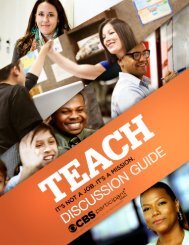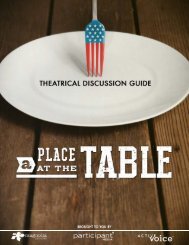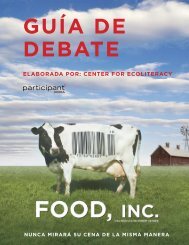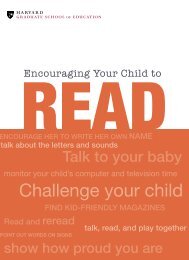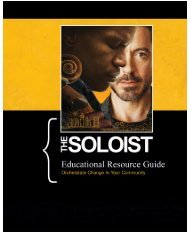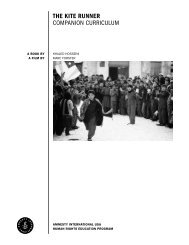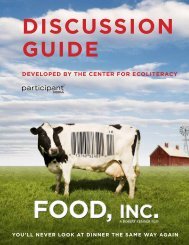Sharpen your conflict resolution skills with our activity guide - TakePart
Sharpen your conflict resolution skills with our activity guide - TakePart
Sharpen your conflict resolution skills with our activity guide - TakePart
- No tags were found...
Create successful ePaper yourself
Turn your PDF publications into a flip-book with our unique Google optimized e-Paper software.
• Similarly, how could you change a cooperative cycle once it’s started into anaggressive one?• How do the two outcomes differ?• Based on this exercise, what is the best way to achieve <strong>y<strong>our</strong></strong> desired outcome in thissort of situation? Why do you think this?• Was there a similarity between the responses you and <strong>y<strong>our</strong></strong> partner brainstormed forthis situation and the responses you observed when <strong>y<strong>our</strong></strong> classmates were arguingover the last chair? Explain.• How did the chair experiment affect how you responded to the situation on <strong>y<strong>our</strong></strong>worksheet?13. Explain to the class that there are times that cooperative choices will be met <strong>with</strong>aggressive reactions and responses. Ask the class how they might manage the process ifthis should happen. How might they redirect the cycle if their attempts at cooperationwere to be met <strong>with</strong> aggression?14. As a concluding <strong>activity</strong>, write the following prompt on the chalkboard or on chart paper.Students can respond in their notebooks or in their j<strong>our</strong>nals. Enc<strong>our</strong>age students to relatethis quote to the activities they completed in class. How might a small problem (notenough chairs) mimic a larger problem (in their community or in the world)?“In matters of truth and justice, there is no difference between large and small problems, forissues concerning the treatment of people are all the same.”–Albert Einstein15. For homework, instruct students to read the newspaper or visit a global news website.Students should identify a significant armed <strong>conflict</strong> from the day’s headlines. Theyshould print the article or clip it from the newspaper. Then instruct students tosummarize the <strong>conflict</strong> and list potential responses–both violent and non-violent–to the<strong>conflict</strong> on a new Student Handout: Cycle of Conflict.Extension Activities and Ideas for Further Learning:• Instruct students to write an in-depth research paper on one of the following significantongoing global <strong>conflict</strong>s. Their paper should include background on the situation,circumstances that are causing the situation to remain unresolved, the underlying reasonfor the <strong>conflict</strong> (i.e., land, governmental power), and a personal reflection on what theylearned from their research, including their own ideas for how the <strong>conflict</strong> might getresolved.o Sudan vs. Darfur rebel groupso Russia vs. Chechen separatistso India vs. Kashmiri separatist groups/Pakistano Uganda vs. Lord’s Resistance Armyo Columbia vs. the National Liberation Army and the Revolutionary Armed Forcesof Columbia (FARC)o Sri Lanka vs. Tamil Eelano Israelis vs. Palestinians• Instruct students to create a “Collage of Conflict.” Students should read the newspaperfor 2 to 3 weeks and clip all the headlines they see which relate to a <strong>conflict</strong>, either on awww.takepart.com/JimmyCarterManFromPlains



